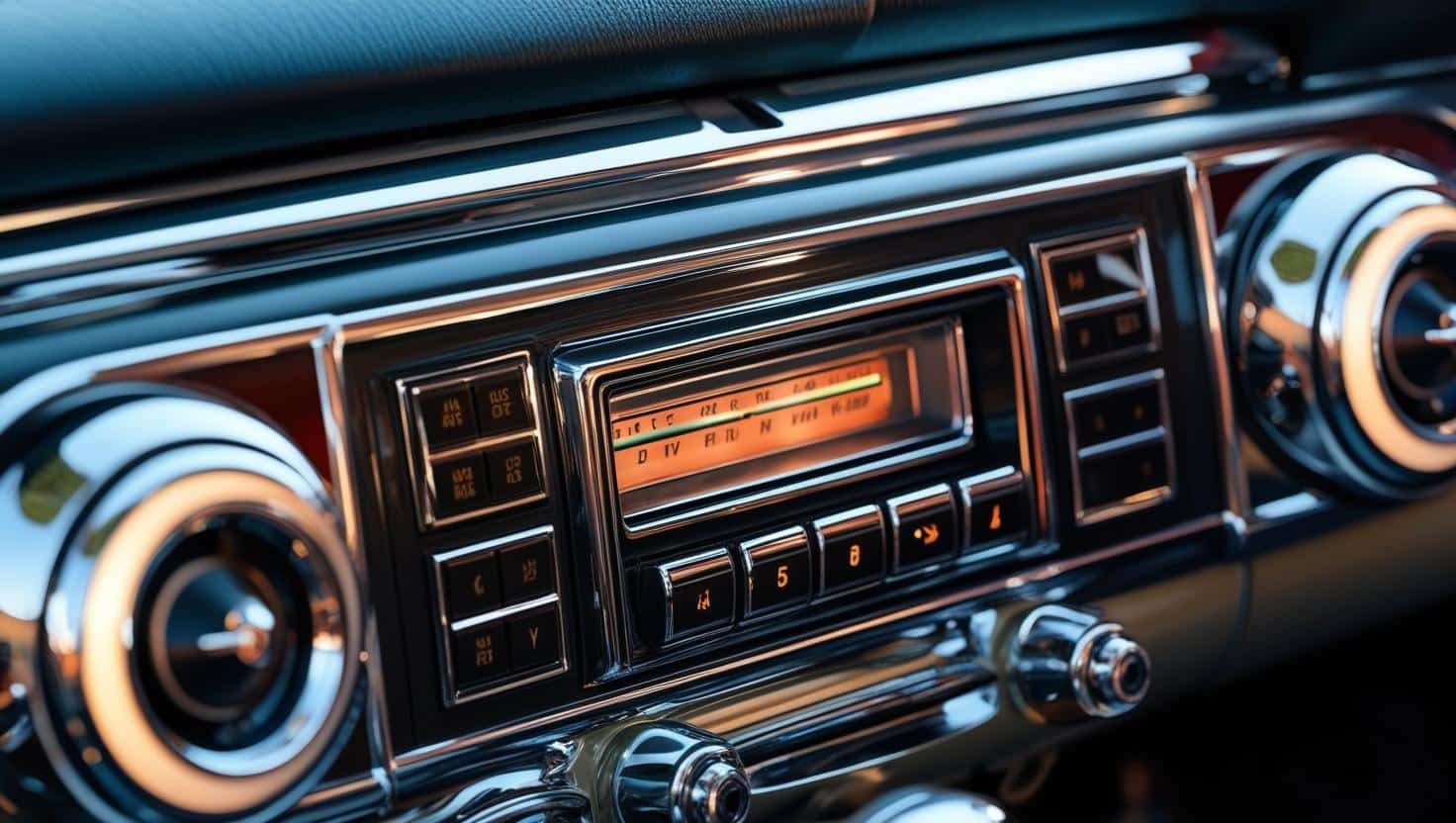Car radios have come a long way from the simple AM/FM receivers of the past. Today’s market offers an array of advanced features—touchscreens, smartphone integration, voice commands, and more—that cater to both audiophiles and those seeking seamless connectivity. Below is a detailed overview of the main types of car radios available, along with essential features and considerations to keep in mind if you’re looking to upgrade your in-car entertainment system.
1. Types of Car Radios
1.1 Single-DIN Units
- Size and compatibility: Single-DIN (2 inches high by 7 inches wide) units are typically found in older or smaller vehicles. They are compact and can often be swapped in or out without significant dashboard modifications.
- Features: Although they have a smaller form factor, many modern Single-DIN head units offer Bluetooth connectivity, USB inputs, AUX ports, smartphone compatibility, and even fold-out touchscreens.
- Pros: Generally more affordable, widely compatible, and relatively easy to install.
- Cons: Limited space for display and controls, so the touchscreen (if present) is often smaller or less intuitive than a Double-DIN model.
1.2 Double-DIN Units
- Size and compatibility: Double-DIN (4 inches high by 7 inches wide) units have a larger front panel, making them suitable for cars with spacious dashboards or built-in double-DIN slots.
- Features: The extra space often allows for bigger touchscreens, full smartphone integration via Apple CarPlay or Android Auto, built-in GPS navigation, DVD playback, and more advanced audio processing.
- Pros: Larger screens for easier navigation and entertainment controls, more room for extra features, often a modern look.
- Cons: Typically more expensive, and not all vehicles have the necessary space unless you do custom modifications.
2. Essential Features to Look For
2.1 Connectivity
- Bluetooth: A must-have for hands-free calling and wireless music streaming. Look for models that offer stable, quick-pairing Bluetooth.
- USB Ports: Useful for charging devices and playing music directly from a flash drive or smartphone.
- AUX Input: A simple and universal way to connect external audio devices if you prefer wired connections.
- Wi-Fi or 4G Connectivity: High-end radios may include built-in Wi-Fi or SIM card slots for internet connectivity, enabling online streaming and real-time updates.
2.2 Smartphone Integration
- Apple CarPlay & Android Auto: These systems allow seamless control over your phone’s apps (maps, music, messaging) directly via the car radio’s touchscreen, including voice command functionality.
- MirrorLink: Some head units support smartphone screen mirroring, letting you duplicate your phone’s display on the car stereo screen. Not as integrated as CarPlay or Android Auto, but still useful for certain apps.
2.3 Display and Interface
- Touchscreen vs. Physical Buttons: Touchscreens provide modern aesthetics and easier interaction with apps. Physical buttons, however, are often more intuitive while driving because you can operate them by feel.
- Screen Resolution & Brightness: A higher resolution and good brightness level ensure visibility in daylight. Capacitive touchscreens (like smartphones) are often more responsive than resistive ones.
- User Interface: Look for an interface that is easy to navigate to minimize distractions on the road.
2.4 Audio Quality
- Built-in Amplifier Power: Measured in watts per channel. A more powerful amplifier can drive your speakers better, but consider separate external amps if high-end audio performance is your priority.
- Equalizer & Sound Settings: Advanced EQ settings, time alignment, and crossover controls help optimize sound. Some top-tier radios include digital signal processing (DSP) for high-fidelity tuning.
- Preamp Outputs: If you plan on adding external amplifiers or subwoofers, ensure your car radio has adequate preamp outputs (usually three sets: front, rear, and subwoofer).
2.5 Navigation
- Built-in GPS: Premium models often include integrated navigation systems with offline maps. This can be handy if you regularly drive through areas with poor mobile coverage.
- Smartphone-Based Navigation: Alternatively, many drivers rely on Apple Maps, Google Maps, or Waze through CarPlay or Android Auto. This often gives you real-time traffic updates.
2.6 Additional Features
- Steering Wheel Controls Compatibility: Some cars have built-in audio controls on the steering wheel. Many aftermarket head units can integrate with these controls via special adapters.
- Backup Camera Support: A Double-DIN radio with a large screen can display feed from a reverse camera, boosting safety and convenience.
- OBD-II Diagnostics: Some advanced units can connect to your car’s OBD-II port (with an adapter) to display vehicle diagnostics, engine data, and performance metrics.
- Detachable Faceplate or Security Features: Older or simpler models sometimes have a removable faceplate for security. High-end radios may come with security codes or anti-theft systems.
3. Leading Brands on the Market
- Pioneer: Known for innovative features, solid sound quality, and a wide range of models—from budget-friendly to high-end.
- Sony: Offers stylish designs, user-friendly interfaces, and good smartphone integration.
- Alpine: Popular for exceptional audio quality, catering to those who prioritize premium sound.
- Kenwood: Provides a balance of quality, features, and competitive pricing. Kenwood eXcelon series caters to audio enthusiasts.
- JVC: Shares technology with Kenwood under the same corporate umbrella, delivering reliable head units with decent sound and feature sets.
- Clarion: Known for marine and automotive audio solutions, often featuring robust construction.
- Chinese/Generic Brands: Many no-name or less-known brands offer budget-friendly Double-DIN units with large touchscreens and multiple features, but quality and after-sales support can be inconsistent.
4. Considerations Before You Buy
- Vehicle Compatibility: Check whether your car’s dashboard can accommodate a Single-DIN or Double-DIN unit. You may need a dash kit or special fascia to install an aftermarket radio neatly.
- Harness Adapters: Modern cars often have complex wiring harnesses that integrate factory audio with other vehicle systems. Make sure you purchase the correct wiring adapter.
- Installation: While some people install car radios themselves, professional installation is recommended if you’re uncertain. It ensures a secure fit and proper integration with the vehicle’s electrical system.
- Budget vs. Features: High-end units can be costly, but they often provide better sound quality, bigger screens, and more advanced connectivity. Weigh how important each feature is for your driving experience.
- Upgradability: If you’re a car audio enthusiast, choose a head unit with enough preamp outputs and expansion options (e.g., subwoofer output, add-on modules for navigation) to accommodate future upgrades.
5. Price Range
- Entry-Level (under $100 / ~€100): Basic Single-DIN units offering Bluetooth, USB, and AUX connectivity. Sound quality is good enough for casual listeners, but advanced features like CarPlay/Android Auto are usually absent at this price point.
- Mid-Range ($150–$300 / ~€150–€300): Both Single-DIN and Double-DIN head units with touchscreens, standard smartphone integration, multiple audio adjustments, and stable Bluetooth. Ideal for most users.
- High-End (above $300 / ~€300): Feature-rich Double-DIN units with large, high-resolution displays, integrated navigation, Apple CarPlay/Android Auto, advanced DSP, and premium build quality. Brands like Alpine, Pioneer, and Kenwood often excel in this segment.
6. Final Thoughts
Upgrading your car radio is one of the best ways to modernize your vehicle, improve your driving experience, and stay connected on the road. Whether you opt for a simple Single-DIN head unit with Bluetooth or a fully loaded Double-DIN touchscreen with CarPlay, the market offers plenty of options to suit different budgets and needs. Always consider compatibility, ease of installation, and the specific features you value most—be it advanced smartphone integration, premium audio, or built-in navigation. With careful research, you can find a car radio that truly enhances your vehicle’s entertainment system and makes every journey more enjoyable.
By assessing your requirements and matching them with the right set of features, you’ll be able to find the perfect car radio that not only fits your budget but also makes your time behind the wheel safer, more connected, and entertaining.



